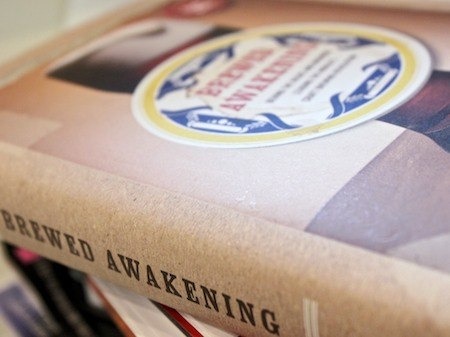Wake Up And Smell The Craft Beer
Josh Bernstein is the kind of guy you want to geek out with over a couple pints. He can wax poetic about fresh-hop beers, fall's fleeting brew delicacy, and advocate on behalf of the little guys, the country's many small, but deserving nanobreweries. He'll happily espouse the virtues of pucker-inducing sour beers, and wear bitter-beer face with pride.
So who better than he to pen what is being described as "the ultimate beer geek's guide"? His new book, Brewed Awakening, out November 1st, takes an in-depth look at the country's growing craft beer scene — providing history, exploring trends, profiling brewers, and offering a wealth of tasting notes and recommendations. We recently sat down with the author to talk beer and the book.
Talk a little about the design and layout of the book — it's by far one of the coolest, and most visually dynamic drink books I've ever come across.
I railed against writing something that would just have big blocks of text with a random beer label stuck in there every so often. The operating principal was to make it look like one of my beer tasting notebooks (there are ripped-out pages, doodles, and stylized beer stain blotches). Drinking beer is about engaging the senses, and I think the design of the book reflects that really well.
The book is incredibly information-heavy (in a good way), but it's also an easy read with a lot of great spotlight stories sprinkled throughout. How do you hope people use the book?
I see it as a kind of coffee table book you can keep in your pocket — the type of book you can read while you have a beer. I want it to be a great primer for every level of beer drinker — the tone is conversational, but professional. There's a lot of substance there, but you can read it in bite-sized chunks. You know, like with beer, you don't have to drink a whole six-pack at once.
Let's talk about the country's craft beer scene: In terms of hot beds, there are the usual suspects — Portland, Seattle, San Francisco — but what are some other areas that deserve attention?
Asheville, N.C., for sure — they have 12 craft breweries there and were voted BeerCity U.S.A. Also Bend, Ore., Chicago, Austin, Long Island (smaller, but still worth noting), and Minneapolis-St. Paul, Minn. (Surly Brewing Co. has been guiding the revival).
Any interesting trends you've been noticing in the craft beer movement as of late?
The colorization of IPAs, for one, I think it really speaks to the popularity of the style. Normally they're a kind of reddish-golden color, but now you're seeing everything from white, hoppy wheat beers to black IPAs that have a dark tint but still drink light. There's also been a bigger emphasis on terroir, and returning back to the land — partnering with local farmers and using area ingredients like honey, herbs, and grains. It's also been interesting to see how the American craft beer movement has been inspiring other places — New Zealand's Epic Brewing Company is a perfect example, making super hoppy beers that emmulate the American style but still has its own unique twists.
You recommend a lot of beers throughout the book — it seems as though you list anywhere from four to 10 for just about every style you discuss. What are some favorite brews you're into at the moment?
Anchorage Brewing's Whiteout Wit Bier — it's easy-drinking, sour, and buttery. Also Booklyn Brewery's Sorachi Ace, a Belgian-style saison that is made using an unusual hop by the same name. The hop variety was actually developed by Japan's Sapporo Breweries, but they couldn't find a commercial use for it. Brooklyn Brewery has used it to make a beer that has a really unique, soft lemony-buttery quality. A couple other favorites are the Smuttynose Wheat Wine Ale, Half Acre's Daisy Cutter Pale Ale, and the Lagunitas Little Sumpin' Sumpin' (a hopped-up American-style wheat beer that drinks as good as it smells). And then also the Starr Hill Brewery's Dark Starr Stout, an American version of a dry Irish stout — a great choice if you're a Guinness drinker.
